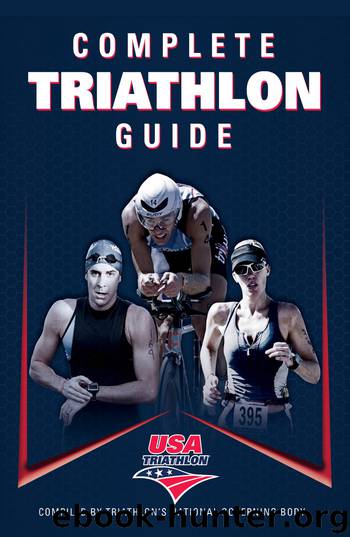Complete Triathlon Guide by USA Triathlon

Author:USA Triathlon
Language: eng
Format: mobi
ISBN: 9781450425612
Publisher: Human Kinetics
Published: 2013-04-12T19:05:32+00:00
PART III
Competitive Strategy
CHAPTER 16
Open-Water Race Tactics
Sara McLarty
Open-water swimming is one of the scariest parts of a triathlon. The murky water; the other competitors; and the lack of lanes, walls, and lines to follow can intimidate even the most fearless competitor. Using the knowledge provided by experienced athletes and coaches can make the first leg of a triathlon more enjoyable and full of success. This chapter covers many aspects of open-water swimming, including training, the start, drafting, transitioning to the bike, and much more, all developed through countless races, learned after making many mistakes, and resulting in a lot of success.
Open-Water and Pool Training
Most triathlon swims take place in the open water, and for a good race performance, open-water training sessions are essential in the weeks before your event. But before diving into the nearest lake or ocean, take a few precautions for your personal safety:
Wear a brightly colored cap to be visible to other swimmers, lifeguards, and boats.
Tell someone where you are going and how far you are swimming.
Swim in a group with other athletes, or have someone stay close by in a boat.
Check with the local authorities to receive permission to swim in the open water.
Stay alert, and be aware of your surroundings at all times.
Also, open-water swimming can help you practice in ways that more closely resemble a race course. Create a practice course using buoys made out of brightly colored plastic jugs tied to a weight or natural landmarks that are tall and easily observable. Use these open-water swims to practice sighting and turning at the buoys. When swimming with other athletes, practice drafting, passing, and dealing with the chaos that occurs at the start and at turn buoys. Learn how to quickly find the strap and unzip your wetsuit while jogging out of the water. Find open water that closely mimics an upcoming race environment to get comfortable with the water conditions (e.g., colder temperatures to practice with a full-body wetsuit).
Although open-water training is necessary as you get closer to race time, most swim training for triathlons takes place in a pool. Most athletes feel more comfortable training in the safety of a pool and enjoy participating with swim groups at local aquatic centers. The best pool is of standard length, such as 50 meters, 25 meters, or 25 yards, and is set up for lap swimming. Small or kidney-shaped backyard pools found as added amenities at homes and hotels may do in a pinch, but an actual lap pool, designed for swimming, is a far superior place to train. Even so, the safe and clear conditions of swim training in a pool do not fully prepare you for the situations that arise in open-water events. Lap pools offer clear water, lane markers, and lines on the bottom of the pool, while open-water courses are usually murky, and directional buoys are few and far between. The following drills are open-water specific and can be used in the pool to help prepare you for some of the open-water conditions you will encounter.
Download
This site does not store any files on its server. We only index and link to content provided by other sites. Please contact the content providers to delete copyright contents if any and email us, we'll remove relevant links or contents immediately.
Shoe Dog by Phil Knight(4167)
The Rules Do Not Apply by Ariel Levy(3906)
Walking by Henry David Thoreau(3234)
Running Barefoot by Amy Harmon(3056)
Crazy Is My Superpower by A.J. Mendez Brooks(2860)
How to Read Water: Clues and Patterns from Puddles to the Sea (Natural Navigation) by Tristan Gooley(2855)
I'll Give You the Sun by Jandy Nelson(2842)
How to Read Nature by Tristan Gooley(2665)
How Music Works by David Byrne(2525)
The Boy, the Mole, the Fox and the Horse by Charlie Mackesy(2448)
Seducing Cinderella by Gina L. Maxwell(2235)
Cuba by Lonely Planet(2184)
The Fight by Norman Mailer(2159)
Going Long by Editors of Runner's World(1921)
Accepted by Pat Patterson(1917)
The Unfettered Mind: Writings from a Zen Master to a Master Swordsman by Takuan Soho(1859)
The Happy Runner by David Roche(1821)
Backpacker the Complete Guide to Backpacking by Backpacker Magazine(1815)
Trail Magic by Trevelyan Quest Edwards & Hazel Edwards(1760)
